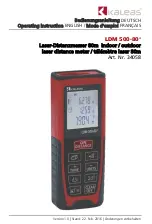
TB-9023
Page 1 of 16
© 2017 DESCO INDUSTRIES, INC.
Employee Owned
EM Eye - ESD Event Meter
Installation, Operation and Maintenance
June 2017
Description
The SCS EM Eye Meter is capable of providing
measurements for many various parameters, which
are determined by the type of sensor connected to the
EM Eye Meter. Below are the three sensors that are
available now:
• ESD Events Detection
– The portable, easy-to-use
EM Eye Meter serves as a measuring instrument for
most ESD signals. The EM Eye Meter measures
the magnitude of ESD events. This meter also
estimates the events’ magnitude for CDM, HBM and
MM models.
• Electromagnetic Field Measurement
– Enables
the EM Eye Meter to be transformed into an EMF
Meter, Power Density Meter and EIRP Meter.
• RF Signal Sensor
– The EM Eye Meter measures
the amplitude of an RF signal.
User Features
Modular Construction
The EM Eye Meter with the modular construction
concept can expand to different applications. With the
current design, it measures the magnitude of most ESD
events when in one of its filter modes, electromagnetic
fields (EMF), power density, effective isotropic ally
radiated power and radio frequency (RF).
Made in the
United States of America
Figure 1. SCS CTM048-21 EM Eye - ESD Event Meter
Figure 3. Inserting the SD card into the EM Eye Meter
USER GUIDE TB-9023
Touch Screen to Power ON
The EM Eye Meter is designed with a modern user
interface. All buttons and controls are within the display
itself. With its display and touch screen, it is easier for
users to quickly navigate through the features that were
built into the meter.
Speaker and Headphone Alarm Outputs
The EM Eye Meter, with a speaker and headphones,
allows flexible means for audible indications, beeping
or “warbling” like a radio. If one is in a noisy place, a
headphone jack for optional headphones can be used
for clearer audio.
Easy Data Logging to Memory Card
The EM Eye Meter supports data logging by using a
microSD card and exports to an Excel spreadsheet.
Having data at hand enables quick analysis. Solutions
can be decided quickly and can be measured on the
spot.
Figure 2. Using the EM Eye Meter
www.
.com
1.800.561.8187


































